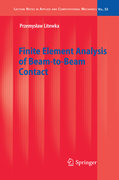
Phenomena occurring during a contact of two bodies are encountered in everyday life. In reality almost every type of motion is related to frictional contact between a moving body and a ground. Moreover, modeling of simple and more complex processes as nailing, cutting, vacuum pressing, movement of machines andtheir elements, rolling or, finally, a numerical simulation of car crash tests, requires taking contact into account. Therefore, its analysis has been a subject of many research efforts for a long time now. However, it is author’s opinion that there are relatively few efforts related to contact between structural elements, like beams, plates or shells. The purpose of this work is to fill this gap. It concerns the beam-to-beam contact as a specific case of the 3D solids contact. A numerical formulation of frictional contact for beams with two shapes of cross-section is derived. Further, a couple of effective methods for modeling of smooth curves representing beam axes are presented. A part of the book is also devoted to analyze some aspects of thermo-electro-mechanical coupling in contact of thermal and electric conductors. Analyses in every chapter are illustrated with numerical examples showing the performance of derivedcontact finite elements. Systematic description of a finite element analysis of beam-to-beam contact State-of-the-Art Written by experts in this field INDICE: Part 1Introduction.- Part 2 Frictionless beam-to-beam contact.- Part 3 Friction in beam-to-beam contact.- Part 4Contact between smoothed beams.-Part 5 Electric contact.- Part 6 Thermo-mechanical coupling.-Part 5 ummary and outlook.- Part 6 Appendix 1. Matrices D and E for beams with rectangular cross-sections.- Part 7Appendix 2. Derivation of variables.- Part 8 Appendix 3. Matrices G,H and M in smoothing procedures.- Part 9Bibliography
- ISBN: 978-3-642-12939-1
- Editorial: Springer
- Encuadernacion: Cartoné
- Páginas: 175
- Fecha Publicación: 19/05/2010
- Nº Volúmenes: 1
- Idioma: Inglés
